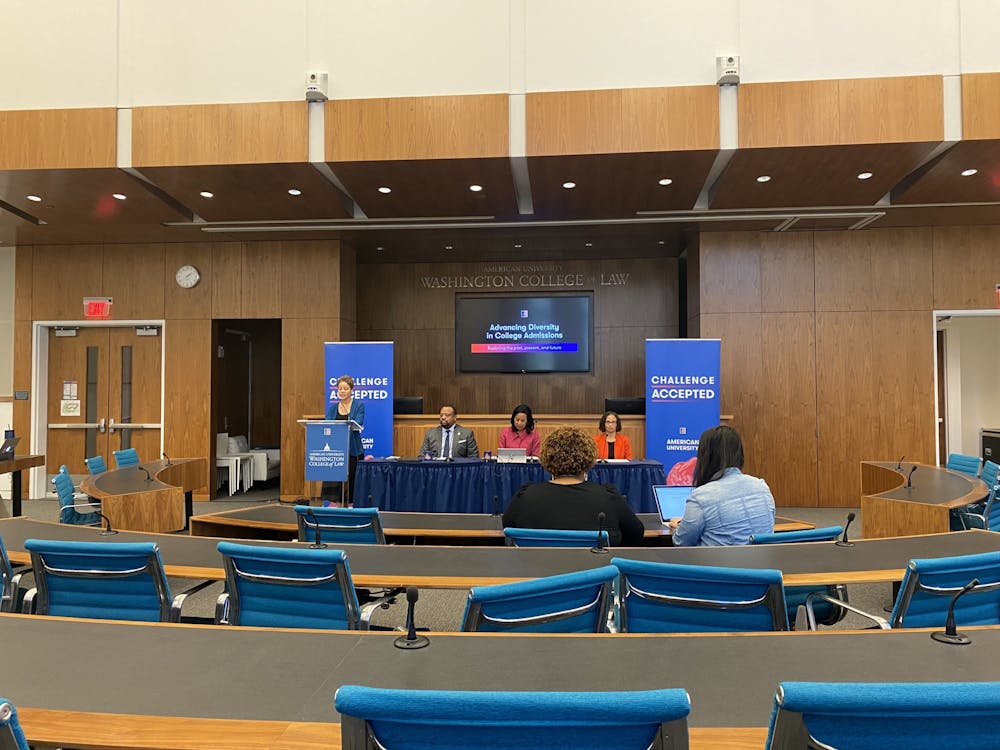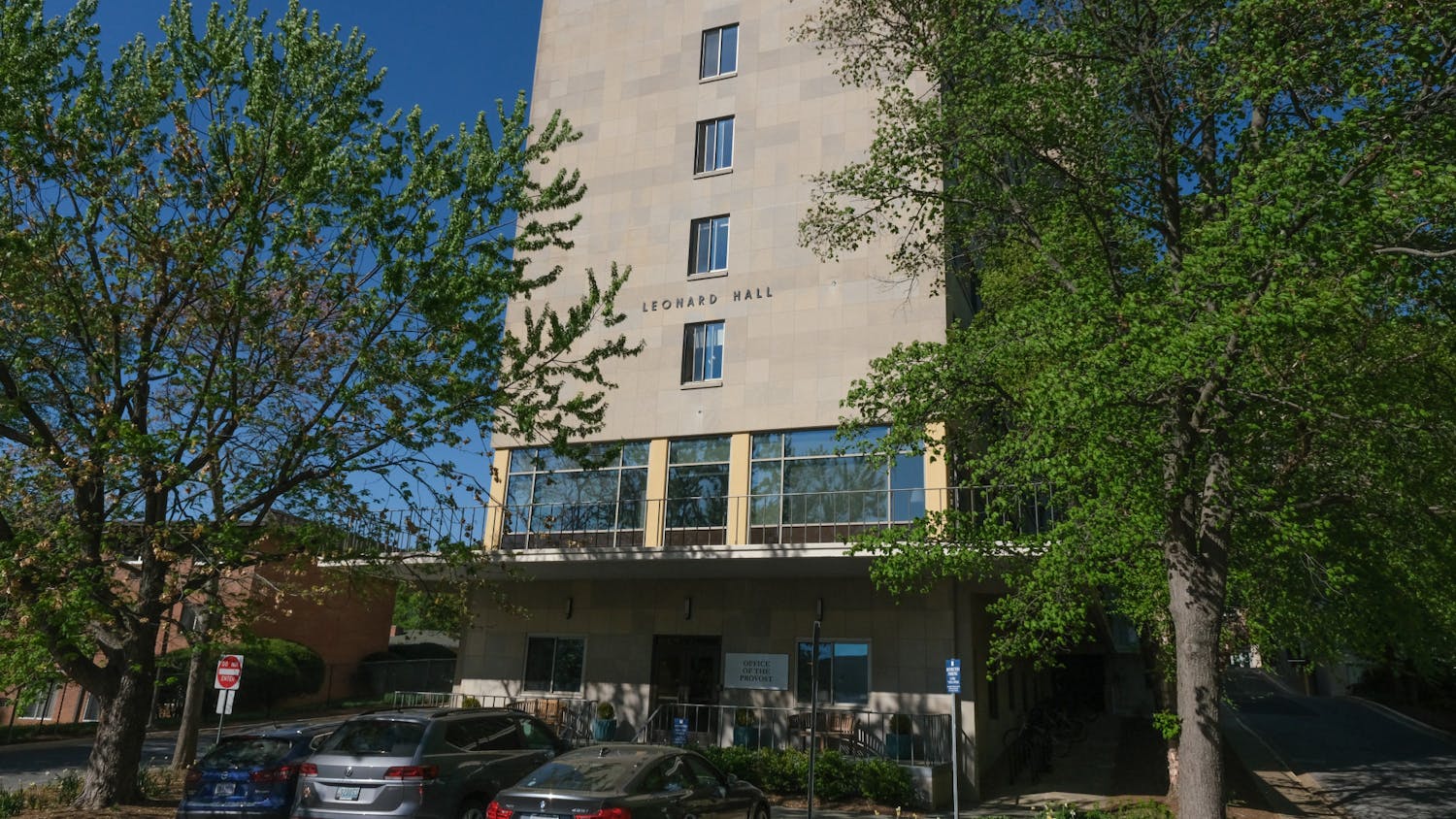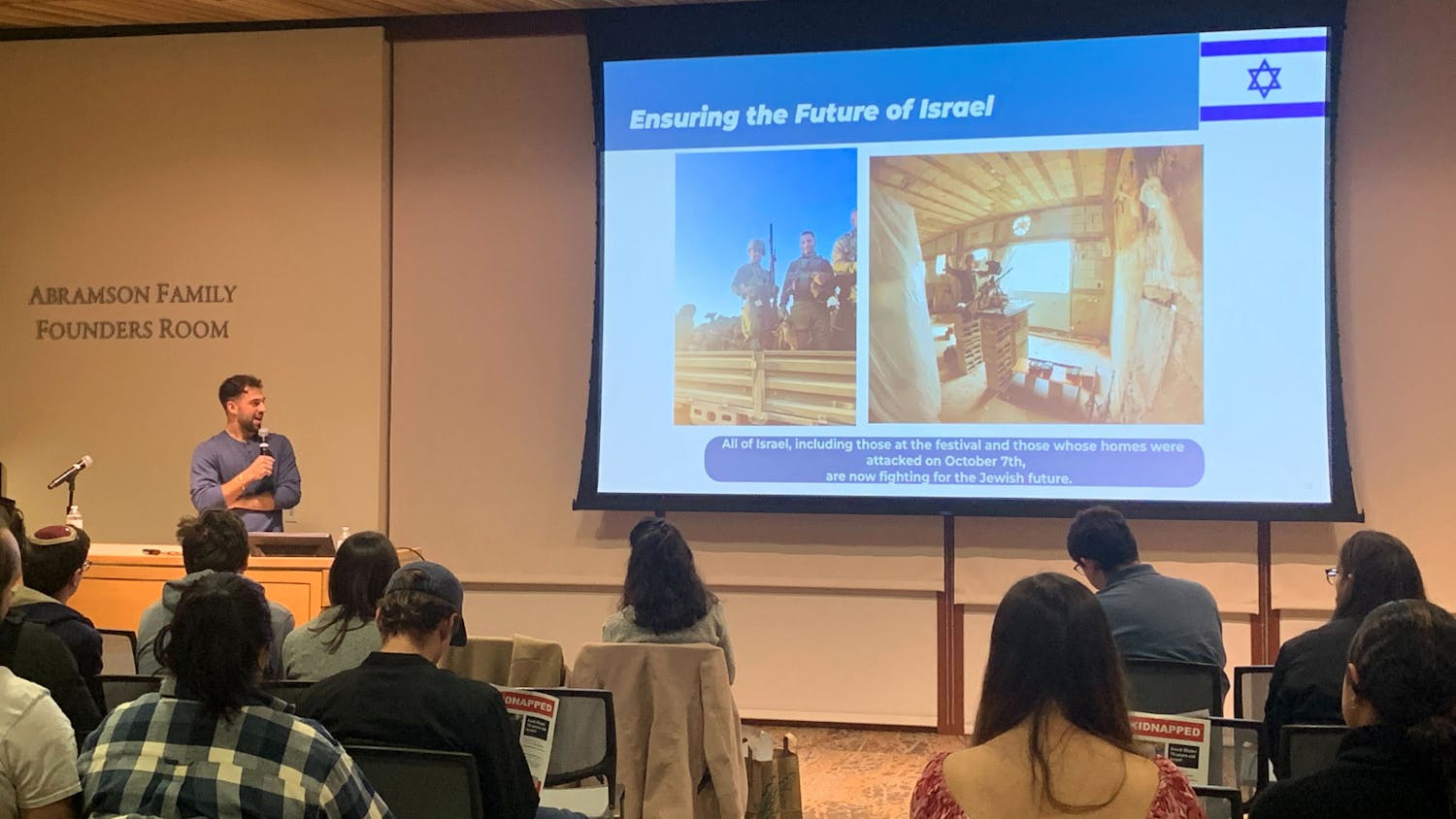Two Supreme Court cases could change the way American University administrators evaluate applicants in the admissions process.
Currently, AU uses race-conscious admissions, meaning that it considers race as one of many factors in a holistic evaluation of applicants, according to Andrea Felder, AU’s interim vice president of undergraduate enrollment.
Legal precedents have long allowed race to be a contributing factor in admissions decisions, provided the policy to consider race is “narrowly tailored” to serve the interest of having a diverse student body, according to Lia Epperson, a professor at the Washington College of Law and renowned civil rights lawyer.
Supreme Court cases Students for Fair Admissions Inc. v. President & Fellows of Harvard College and Students for Fair Admissions Inc. v. University of North Carolina challenge the constitutionality of race-conscious admissions and could overturn the decades-old precedent set in 1978 by the Regents of the University of California v. Bakke case. If the Supreme Court decides that these policies are unconstitutional, AU would need to adjust its admissions policies.
Felder said considering an applicant’s race in the college admissions process helps build a more diverse student body.
“AU is deeply committed to our Inclusive Excellence Plan, and we believe that a diverse student body is important to our community,” Felder wrote in an email to The Eagle. “AU considers race, among many other factors, as part of our individualized holistic review process. Our primary consideration is the applicant’s academic readiness and likelihood for success at AU.”
Felder added that these factors include high school courses and grades, involvement in extracurriculars, honors and awards, application essays, socioeconomic status, test scores and letters of recommendation.
Beyond using race-conscious admissions, AU also works to remove barriers that might prevent students from applying and reaches out to specific communities using tailored recruitment, according to Felder. The Supreme Court cases are not likely to impact these additional strategies.
Felder gave examples of AU’s work to remove barriers, citing AU’s test-optional policy and reducing the number of essays required to apply for students and providing financial aid to students.
“Starting with several years ago, test-optional policies at AU — we were certainly not the first institution to institute test-optional policy, but we were an earlier adopter of that policy,” Felder said.
AU’s Strategic Plan includes efforts to increase diversity in the study body through tailored recruitment. Strategic Imperative Section Three describes efforts to recruit and retain “Latinx, Black/African American, Asian, military-affiliated, and DC public school students” to try to ensure that the student body comes from a variety of backgrounds and experiences, according to the plan’s website.
“These strategies will focus on the value proposition of an AU education for those populations, the support they will receive to help them successfully navigate AU, and the sense of belonging they can find at AU,” the Strategic Plan reads.
Felder noted that AU made these efforts prior to adopting the Strategic Plan in 2019.
“I will add that the University has done several efforts to recruit students from diverse backgrounds, long before the Strategic Plan,” Felder said. “But it just elevates the need to continue that work.”
The Inclusive Excellence Plan also notes that AU’s Office of Enrollment will continue to partner with organizations that focus on educational opportunities for students of color and low-income students.
“We will recruit, retain, and recognize a diverse body of AU students, faculty, staff, administrators, and Board members by increasing access and advancing inclusion for equitable outcomes, with a specific focus on racial equity,” the Inclusive Excellence Plan reads.
The 2019–2025 Strategic Plan Progress Report: Year 4 notes that AU has finalized partnerships with College Track and IDEA Public Schools, organizations that focus on providing opportunities for students of color, first-generation and low-income students.
The Strategic Plan notes that AU is working to improve its recruitment strategies for international students by creating recruitment hubs, first in the Middle East and Mediterranean and later in Latin America and Asia.
The plan states that AU will “explore what steps are necessary” to become a Hispanic-Serving Institution — an institution at which 25 percent or more of the student body is made up of Hispanic students — by 2030.
The Strategic Plan also includes investments in scholarships for undergraduate students. It notes an investment of up to $6.5 million to increase scholarships for undergraduate financial aid. The Progress Report said AU has removed barriers in the application and enrollment process, citing a waiver for Pell Grant-eligible students for the early housing and enrollment deposit.
Since its founding in 1893, major legal and political shifts allowed AU to develop policies geared towards increasing diversity in its student body.
‘Advancing Diversity in College Admissions’ panel
The Advancing Diversity in College Admissions panel on April 12 broke down the history and legal precedents of race-conscious admissions and affirmative action, explaining how American colleges and universities came to adopt race-conscious policies and how organizations and individuals have challenged them. Roger A. Fairfax Jr., the dean of WCL, led the panel featuring Epperson and Sara Clarke Kaplan, a professor of literature and the executive director of the Antiracist Research & Policy Center.
Epperson began by explaining how the 14th Amendment’s provision for equal protection under the law provides the context for the issue of race-conscious admissions in the U.S.
“[With] the issue of affirmative action in higher education, that context can be traced back to a moment in time, which was a really sort of fundamental restructuring of the social contract in the United States,” Epperson said at the event. “And that is the end of the Civil War and the passage of the Reconstruction amendments.”
She noted how, despite conversations about increasing racial equity in the Reconstruction Era — the years after the Civil War during which the U.S. began to reckon with its history of slavery — the 1896 Supreme Court case Plessy v. Ferguson cemented racial segregation into American society for decades to come.
Epperson went on to describe efforts by the NAACP Legal Defense Fund to overturn the Plessy decision, highlighting the case of Sweatt v. Painter.
“There had been a series of cases before that highlighting, essentially, the fallacy that state-mandated racial segregation could ... ever lead to an equality of opportunity in education,” she said. “And in [Sweatt v. Painter], you could see that almost as the first case in which the Supreme Court outlines the necessity of diversity for a strong democracy.”
Epperson discussed the landmark case Brown v. Board of Education of Topeka — which overturned Plessy v. Ferguson and established that racially-separated education was inherently unequal — before pivoting toward the current conversation around race-conscious admissions and affirmative action.
She said the Supreme Court uses the highest level of review — strict scrutiny — to look at race-conscious admissions policies, meaning that it requires these policies to serve compelling government interests and be narrowly tailored to do so. The compelling government issue in question, she said, is the benefit of a diverse student body. She added that race is the only factor in admissions which triggers strict scrutiny in the courts.
“[Colleges and universities] are looking at a host of factors,” Epperson said. “But the only one that triggers strict scrutiny is race, which means that a college or university can, to their heart's content, really sort of put a thumb on the scale for athletes, major donors, legacies, for socioeconomic status [and] for demographic diversity, but they do not trigger heightened scrutiny.”
Kaplan discussed the political history of race-conscious admissions and affirmative action.
She said that though President John F. Kennedy was the first to use the term “affirmative action,” it was civil rights leaders who first said affirmative action was necessary for a truly equitable society.
“Martin Luther King [Jr.] and other activists in [the Southern Christian Leadership Conference] and related organizations who first began to argue that, even if we see the kinds of shifts in civil rights policy that we saw … it would be impossible to see actual structural equity without engaging in affirmative policies that sought to rectify long-standing forms of structural inequity,” Kaplan said.
She said the purpose of affirmative action has changed since that time.
“In fact, the two goals of affirmative action were this: first to rectify entrenched racial inequities created by centuries of legalized captivity, exclusion, exploitation and disenfranchisement,” Kaplan said. “And second, to be used as a vital policy tool to address ongoing racial discrimination and structural barriers to access to higher education created by other non-education-related modes of racial discrimination.”
Kaplan went on to explain how this shift led some white Americans to claim that race-conscious admissions were discriminating against them. She said this argument formed on an institutional rather than individual level, adding that it was large political organizations that pressed these claims in the courts and in ballot measures.
Current court cases
Epperson also outlined current Supreme Court cases. The case against Harvard University alleges intentional discrimination against Asian American students and lack of consideration for race-neutral alternatives — other ways to look for diversity without explicitly considering race — in the admissions process. She said the case against UNC Chapel Hill alleges that race is considered too heavily as a factor of the college admissions process.
Epperson also said the case against Harvard is the first case to challenge race-conscious admissions at a private university, showing “that for most every private university in the United States, the issues are just as salient as they are for the public universities under the equal protection clause.”
She said that both schools had discriminated against applicants of color for the vast majority of their histories.
She also said it was important to remember that both previous rulings from Supreme Court cases and rulings from lower courts in these cases have consistently ruled that race-conscious admissions are acceptable to serve the interest of having a diverse student body. Despite this, she said, it is possible that the current cases could change the precedent.
“So many people believe that despite the fact that there is no circuit split, despite the fact that we have 40 years of precedent, despite the fact that the lower court rulings have all upheld the constitutionality of the existing plans, that we have a court that may likely make some changes to the current doctrine,” Epperson said.
There are three ways this situation is likely to play out, according to Epperson. It is possible that the Supreme Court will make rulings specific to each school or that they will decide that the policies at these schools are not specific enough to serve the interest of diversity. It is also possible that the Supreme Court could decide that diversity is no longer a compelling government interest and overturn past rulings.
Race-neutral alternatives have repeatedly failed to produce diverse student bodies, Epperson said.
“And the bottom line is that it was insufficient," Epperson said. “There would be a significant decrease in racial and ethnic diversity of the university, were they to completely remove any consideration of race.”
Kaplan expanded on Epperson’s comment, saying misconceptions about race-conscious admissions have led many Americans to oppose these policies.
She explained the flaws in the claim that Harvard has intentionally discriminated against Asian American applicants in order to admit more Black and Latino students, saying that there are simply many more Asian American applicants and very few Black and Latino applicants.
“The problem is not discrimination against Asian American students at Harvard admissions per se,” said Kaplan. “The problem is that there's a discrimination against Black and Latinx people in the United States that reduces the level of applications to institutions like Harvard. So what we see [is] there are fewer applicants, so there's a higher percentage that are going to be admitted.”
Kaplan added that campaigns such as Students for Fair Admissions divide marginalized groups further.
“Instead of being able to see how that history of structural racism continues to make it hard, even for people of color, who we imagined to be, quote, unquote, ‘overrepresented in higher education’ … these kinds of political campaigns are effectively pitting different historically marginalized and excluded groups against each other in ways that taint the idea of race-conscious admissions as a whole,” Kaplan said.
She closed by saying that she thinks these cases provide an opportunity to rethink the purpose of race-conscious admissions. She said she wants to consider what would happen if we were to reframe the compelling interest of race-conscious admissions.
“What happens when we actually argue — as [AU’s] Inclusive Excellence Plan does — that beyond the compelling interest in a diverse student body, that institutions like this have … a compelling interest in maintaining racial equity, increasing racial justice and remedying racial inequity?” she asked.
This article was edited by Zoe Bell, Jordan Young and Abigail Pritchard. Copy editing done by Isabelle Kravis.





